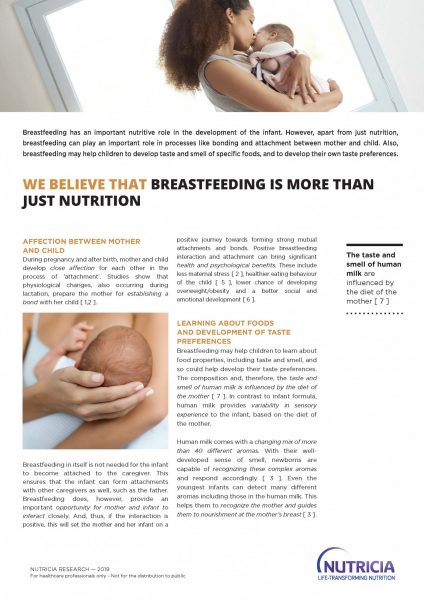Not only does breastfeeding provide babies with optimal nutrition from birth, it also shapes relationships with caregivers, future taste preferences and it helps emotional development.
Affection between mother and baby
During pregnancy and after birth, the mother and baby develop a close affection for one another, a process that’s known as ‘attachment’. Studies show that physiological changes, that also occur during lactation, prepare the mother for establishing a bond with her baby1,2. Breastfeeding alone is not needed for the baby to become attached to the caregiver; the infant can form attachments with other caregivers as well, such as the father. Breastfeeding does, however, provide an important opportunity for mother and baby to interact closely. If the interaction is positive, this will set the mother and infant on a positive journey towards forming strong mutual attachments and bonds. Positive breastfeeding interaction and attachment can bring significant health and psychological benefits. These include less maternal stress2, healthier eating behaviours in children5, a lower chance of becoming overweight and developing obesity in later life and better social and emotional development6.
Learning about foods and development of taste preferences
Breastfeeding may help children learn about food properties, including taste and smell, so could help develop taste preferences. The composition and, therefore, the taste and smell of human milk is influenced by the mother’s diet7. In contrast to infant formula, human milk provides a varied sensory experience for infants, based on the diet of the mother.
Breast milk contains a constantly changing mix of more than 40 different aromas. With a well-developed sense of smell, newborn babies are capable of recognizing these complex aromas and responding accordingly3. Even very young babies can detect many different aromas, including those in human milk. This helps them recognize their mother and guides them to find nourishment at the mother’s breast3.
The aromas in human milk may also influence the child’s preferences for certain foods. If a mother consumes a healthy diet during lactation, the child might accept similar tastes more easily when complementary feeding begins. On the other hand, when a mother consumes a less healthy diet, this may lead to the child preferring less healthy foods4.
Breastfeeding plays an important role in developing healthy eating habits in babies and young children during the first 1,000 days.

Publication: Breastfeeding is more than just nutrition
References
- Jansen, Jarno, Carolina de Weerth, and J. Marianne Riksen-Walraven. “Breastfeeding and the mother–infant relationship—a review.” Developmental review 28.4 (2008): 503-521.
- Hahn-Holbrook, Jennifer, and Martie Haselton. “Is postpartum depression a disease of modern civilization?.” Current directions in psychological science 23.6 (2014): 395-400.
- Vaglio, Stefano. “Chemical communication and mother-infant recognition.” Communicative & integrative biology 2.3 (2009): 279-281.
- Cooke, L., and A. Fildes. “The impact of flavour exposure in utero and during milk feeding on food acceptance at weaning and beyond.” Appetite 57.3 (2011): 808-811.
- Anderson, Sarah E., et al. “Quality of early maternal–child relationship and risk of adolescent obesity.” Pediatrics 129.1 (2012): 132-140.
- Handbook of Attachment, Second Edition: Theory, Research, and Clinical; Jude Cassidy & Philip R Shaver. (2008) Editie 2, Uitgever Guilford Press; ISBN 1606235842, 9781606235843
- Lönnerdal, B. O. “Effects of maternal dietary intake on human milk composition.” The Journal of nutrition 116.4 (1986): 499-513.
BA19-485
